Downy Wood Mint is a perennial wildflower native to Eastern North America[1]. Scientifically known as Blephilia ciliata, it grows 12-30” tall in full sun and well-draining soil[2][3]. Blooming purple flowers about four weeks in mid-Spring, it attracts a huge number of pollinators[4].

This is one of those obscure native flowers that just doesn’t seem to get much love, and it shouldn’t be that way! Downy Wood Mint is the total package when it comes to native plant gardening, even for traditional gardeners. It has brings four key benefits in that it’s pretty, attracts loads of pollinators, it is virtually deer and rabbit proof, and it isn’t aggressive! This plant grows really well in dry to medium moist soils that drain well, and is basically trouble free.
Now, this is one of only two natives in the Blephilia genus, the other is Hairy Wood Mint, which I also grow to compete with Japanese Stilt Grass. But Downy Wood Mint looks similar, however it has purple flowers (as opposed to white), and it is clump forming, rather than rhizome running like Hairy Wood Mint.
This is a native plant you could give to your Native-hating neighbors as a gift, and they would be pleased! It might even make them come around to the idea that natives are just better. Seriously – this is an easy plant to grow, is adaptable, and it looks great. Read on to get more details into this awesome flower.
Native Range
The primary native range of Downy Wood Mint is the Eastern United States, from the Oklahoma-Arkansas border to Michigan, East to Vermont and the Carolinas. There are isolated pockets in Southern Ontario Canada as well[1].

Reference Table
| Scientific Name | Blephilia ciliata |
| Common Name(s) | Downy Wood Mint, Downy pagoda plant, Ohio Horsemint |
| Native Range, USDA Zone | Eastern United States, USDA Hardiness Zones 4-8 |
| Bloom Time | May-June |
| Bloom Duration, Color | Four weeks, Blue/Purple |
| Height | 12-30″ |
| Spacing / Spread | 6-18″ |
| Light Requirements | Full sun to part-sun |
| Soil Types | Any, as long as it drains well |
| Moisture | Dry to medium moisture |
| Fauna Associations / Larval Hosts | Bees, butterflies |
Benefits of Downy Wood Mint
Beauty
The whorled flowerheads of Downy Wood Mint standing tall in the wind are a beautiful site. The best word I can come up with is ‘handsome’ in that the plant is generally erect, and the flowerheads all seem to bloom in unison.
Wildlife
Looking to attract some pollinators? Well look no further – a grouping of three plants will be buzzing with activity from dawn until dusk. Downy Wood Mint attracts numerous species of bee and butterfly.
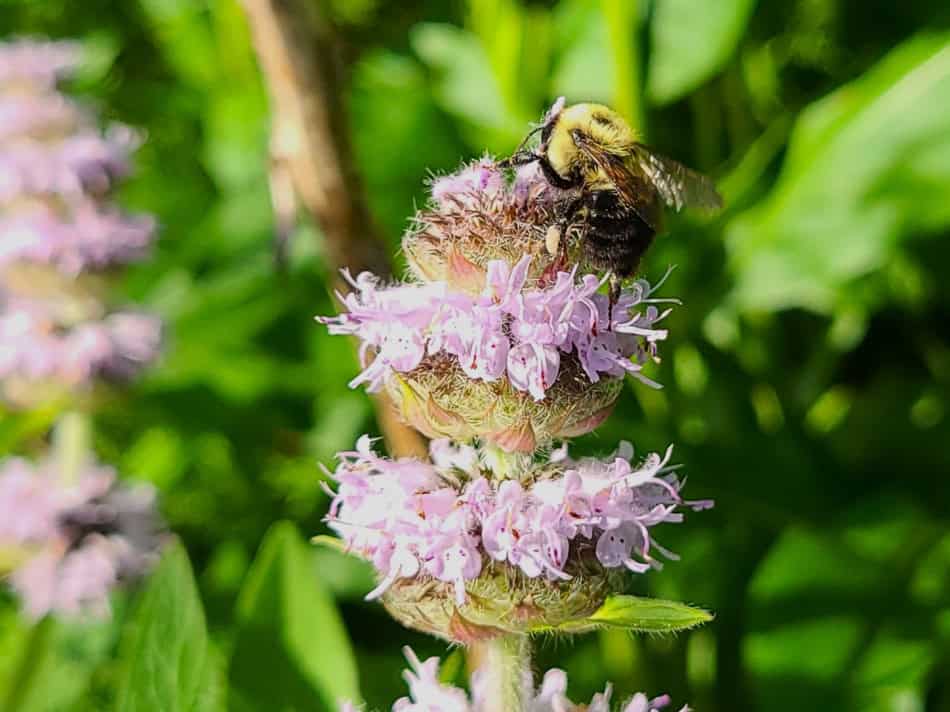
Deer and Rabbit Proof
The aroma from this foliage is strong….strong enough to keep deer and rabbits away! You won’t have to worry about deer or rabbit damage with this plant.
A well behaved mint?
It’s no secret that most members of the mint family have an aggressive reputation. However, after growing Downy Wood Mint for several years I can say that this particular species is actually well-behaved. It hasn’t spread at all, only the clump growing in size. And that is easy to manage with a small amount of root pruning!
Drought tolerant
Downy wood mint is drought tolerant. That is what references say, and I can 100% endorse this as I’ve grown it for several years in flowerbeds that I never water, and they are beat down by the sun all day long. So, the conditions are not unlike a hell strip. But this plant consistently looks great despite these normally inhospitable conditions.
Identification and Characteristics
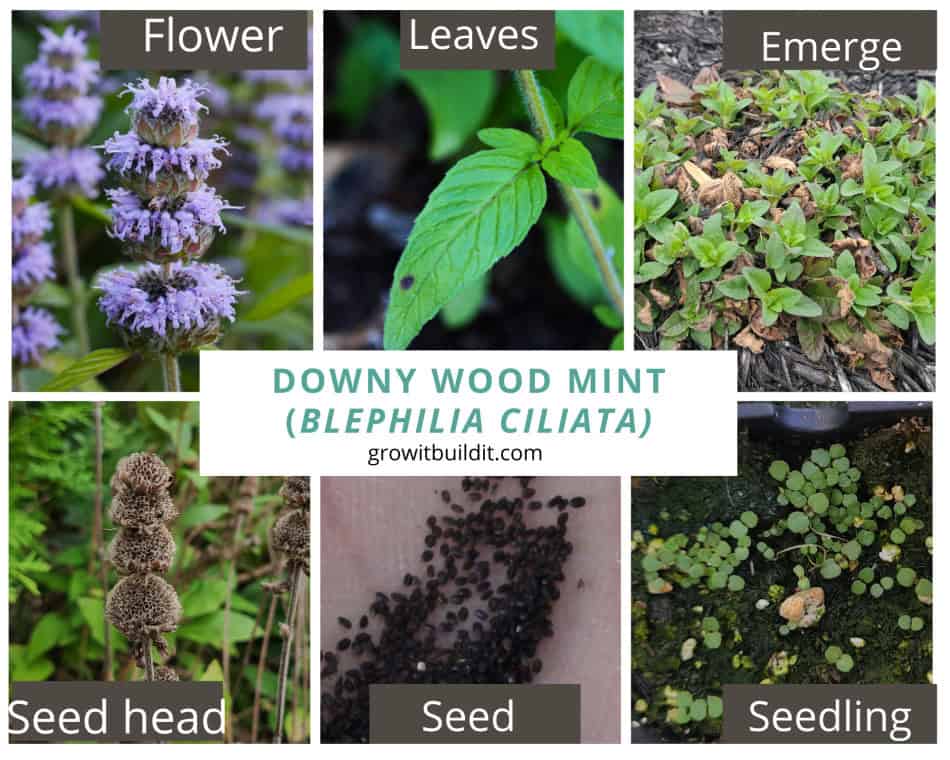
Stalk
The overall plant will consist of basal leaves on the ground, where stalks will arise. The stalk is square with numerous small white hairs that lean against the side. It’s common name, ‘Downy’ refers the the white hairs that cover it’s stem.
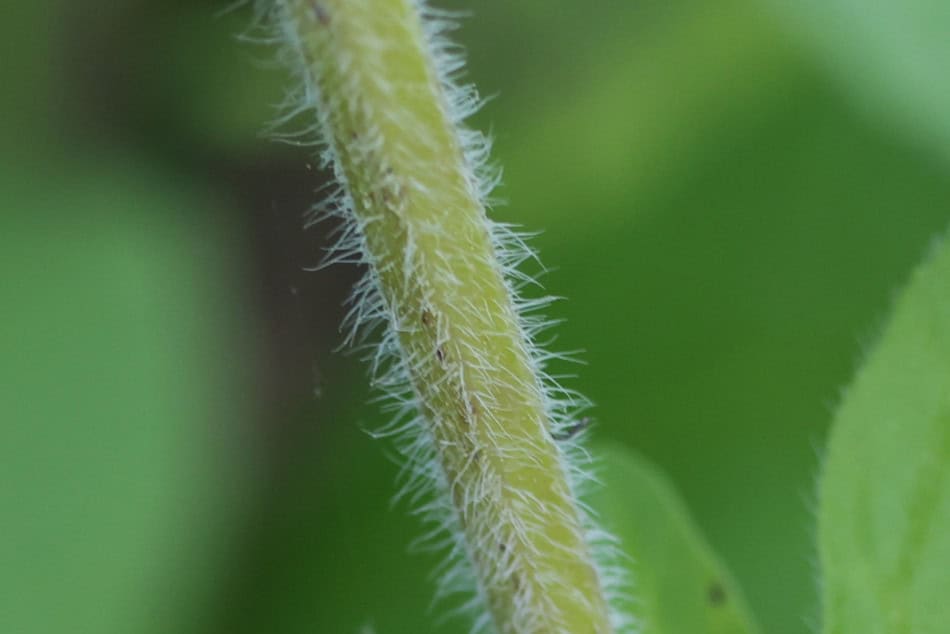
Leaf
Opposite leaves up to 3” long by half-as wide are generally lanceolate in shape and dark green in color[2]. There are generally two leaflets at the base of stem leaves, The margins are ciliate. There will be basal leaves on the ground that have pinnate veins and small white hairs.
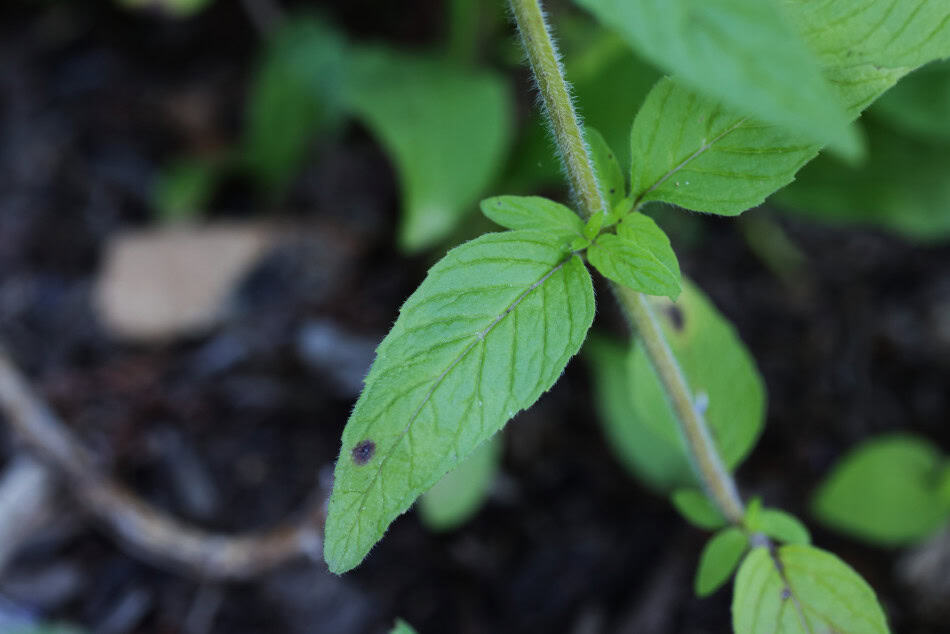
Flower
Along the upper half of the central stem, there will be whorled clusters of flowers that appear almost like rings of flowers around the stalk. They are two lipped, with purple spots on the lower lip, and the overall color is anywhere from white to lavender, to purple or blue. The overall cluster is approximately 2-1/2” diameter, and it is shaped like a disc.

Root
The root system will consist of a central taproot/crown and be clump forming. When it comes to members of the mint family, they have a reputation for aggressiveness, but this one is different and not aggressive.
Growing Conditions
Downy Wood Mint will prefer full to part-sun and medium-moist to dry soils. For soil texture, it really isn’t picky as long as it drains well. So, do a drainage test to make sure it will be ok, and then plant away!
Fertilizer
Regarding fertilizers, you should not fertilize Downy Wood Mint. As a native plant, it just doesn’t need it. In fact, a nitrogen rich fertilizer could cause the plant to grow too tall possibly leading it to topple over.
How to save seed
You can save seed from the flowerheads. About one month after blooming, as the flowerheads look brown/dry, simply clip off the stalks and carefully place it in a brown paper bag, while doing your best to keep the stalk upright so the seed doesn’t tumble out. Place the bag in a cool dry place (like a garage) out of the sun for about a week. Then, vigorously shake the bag to release the seed. Remove the stalks, and inside the bag will be mostly just seed remaining. You can store this seed for a year or two in an envelope in a cool dry place.

How to Grow Downy Wood Mint from Seed
To grow it from seed, it is relatively straightforward however it does have a pretreatment requirement. The seed needs to go through a winter of cold-moist conditions to improve the germination rate. We can do this by either winter sowing the seed (my preference), or cold-moist stratifying the seed for 60 days prior to planting. I have guides on both winter sowing and cold-moist stratifying using the fridge[2][5].

But to plant the seed (whether planting stratified seed or winter sowing), simply fill a suitable container with moist potting soil. Tamp it somewhat firm with your hand, and then scatter some seeds on top. Press the seeds into the soil, but don’t cover them up. They need exposure to sunlight to germinate.
Place the container in a location that gets morning sun and afternoon shade. Germination will occur when temperatures are reliably above 60-70F.
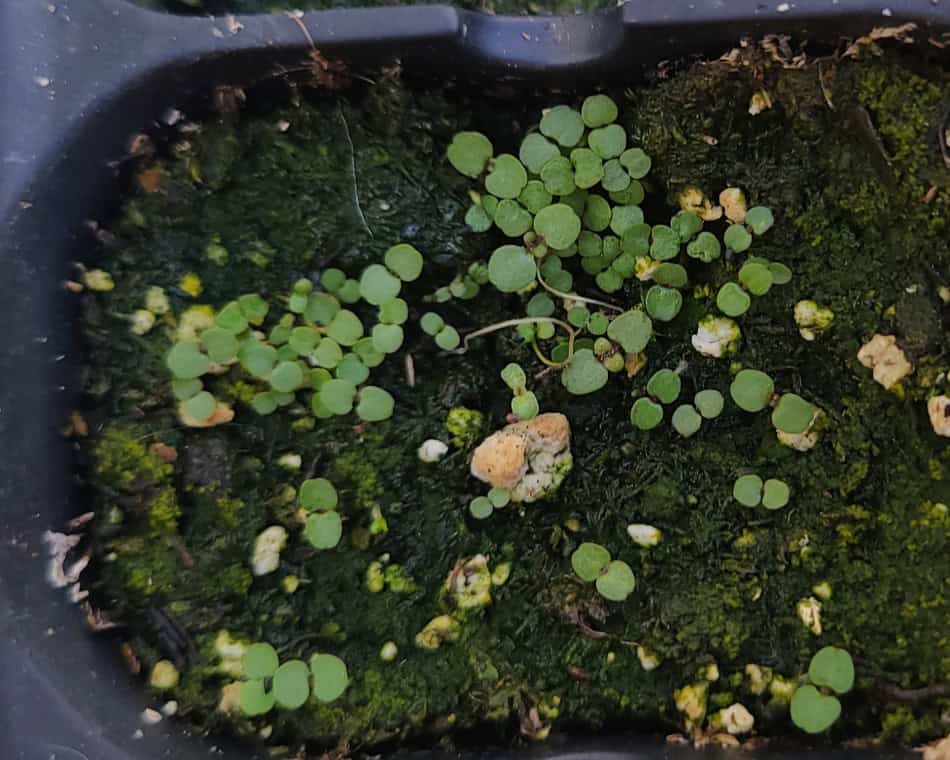
After several weeks, once a couple sets of true leaves develop you can separate seedlings or transplant to their final location.
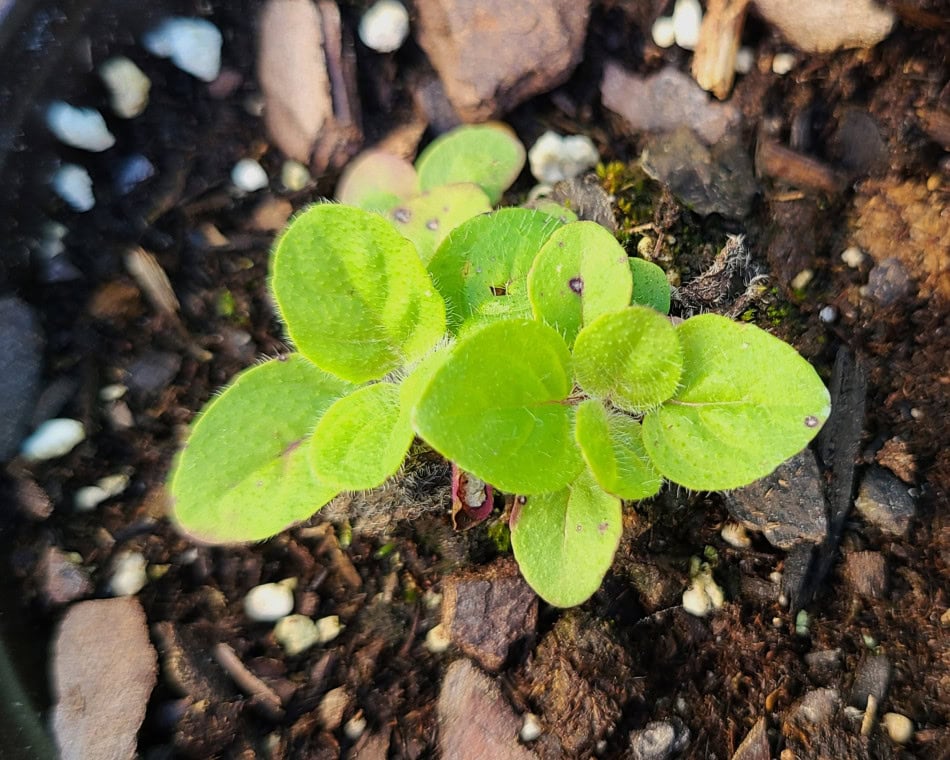
If you wish to direct sow the seed, in Autumn, simply scatter the seed on disturbed soil, and then walk on it to ensure good contact. You should get some plants come Spring.
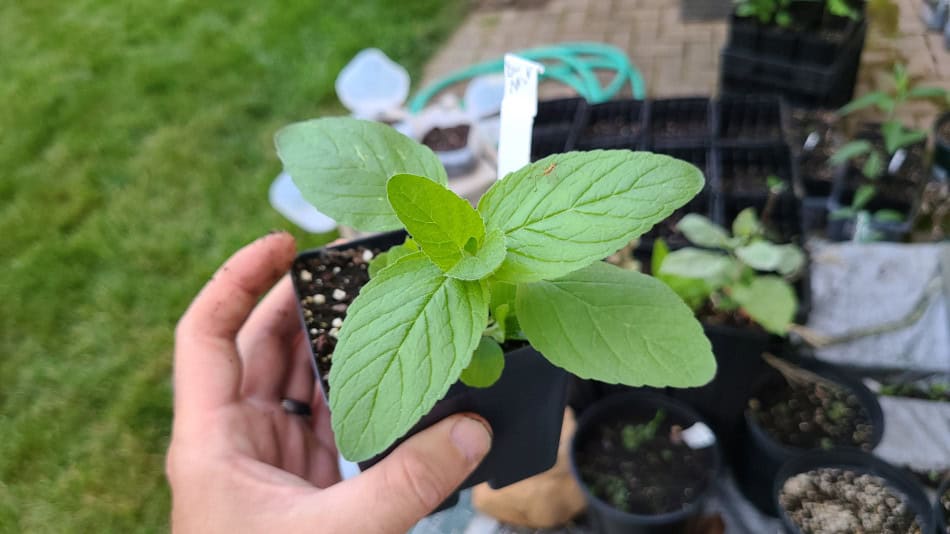
Wildlife, Pests, and Diseases associated with Downy Wood Mint
Pollinators
This is an important plant to pollinators! Over 75 different species of pollinator have been observed visiting the flowers[4]. Some of these would include long and short-tongued bees, butterflies, and pollinating flies.
Deer and Rabbits
As a member of the mint family, the foliage is pungent enough to dissuade deer and rabbits from eating it. Yes, you read that correct – this plant is basically deer and rabbit proof!
Where you can buy Downy Wood Mint
So, this is not a common flower sold in nurseries. Your best bet to locate plants would be to seek out a native plant nursery (see our interactive map to locate one near you). But really though, if you are reading this in fall to early Spring, you should just order some seed as it’s so easy to grow and germinate.
Where to buy seeds
We have ordered a variety of native flower seeds from Everwilde Farms, which you can order right from Amazon through our link on our RECOMMENDED PRODUCTS PAGE. (We may earn a small commission when you purchase through our links, at no cost to you. This helps support our website.)
Uses of Downy Wood Mint
Landscaping
Downy Wood Mint is easy to landscape with – just place it in a sunny location that has well-draining soil. It will thrive without any further care. It is actually one of the better choices for a ‘hell strip’ or garden that is near a road or sidewalk. Now, just note that it isn’t the prettiest flower by mid-summer as the stems will go dormant (basal leaves remain). But, it can be a solid component of any garden.

Companion Plants
There are a number of companion plants that grow well with Downy Wood Mint. Some suggestions would be the following: (all these plants like similar growing conditions)
- Aromatic Aster
- Butterfly Weed
- Harebell
- Hoary Vervain
- Liatris punctata
- Spotted Bee Balm
- Praire Dropseed (grass)
- Little Bluestem (grass)
- Perennial Black Eyed Susan
- Tennessee Coneflower
Medicinal Uses
There is only one documented use I could find on Downy Wood Mint for medicinal purposes. And that was by the Cherokee, who used a poultice of leaves for relieving headaches[6].
Final Thoughts
Downy wood mint is an attractive perennial that doesn’t get enough love from the gardening community. It looks great, brings in all the pollinators and is basically deer and rabbit proof. It sort of is the total package when it comes to native plant gardening for a traditional gardener, or someone who says they ‘don’t have a green thumb’.
Find more native plants here
References:
[1] – Blephilia ciliata. USDA NRCS.
[2] – Harold W. Rock. Prairie Propagation Handbook, Wehr Nature Center of Wisconsin. 1971, pp
[3] – Hemmerly, Thomas E. Wildflowers Of The Central South. Nashville, Tenn. : Vanderbilt University Press. 1990. p140
[4] – Robertson, Charles. “Flowers and insects; lists of visitors of four hundred and fifty-three flowers.” (1928).
[5] – Richter, Lane. “Germination and Growth of Native Understory Forbs in Relation to Shade Levels.” (2007).
[6] – Hamel, Paul B. and Mary U. Chiltoskey, 1975, Cherokee Plants and Their Uses — A 400 Year History, Sylva, N.C. Herald Publishing Co., page 45
Recent Posts
This is going to be a brief article explaining and documenting how to grow Hedge Apples from seed. If you need a windbreak, hedge, or just want to try to grow them as a fun project, well, you've...
Showy Milkweed is a wildflower native to Western North America. Scientifically known as Asclepias speciosa[1], it typically grows 1-3' tall in full sun and well draining soil[2]. Blooming showy...

